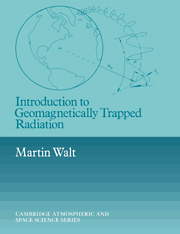Book contents
- Frontmatter
- Contents
- Preface
- List of symbols
- Useful constants
- Geophysical quantities
- Energy equivalents
- 1 The Earth's radiation belts
- 2 Charged particle motion in magnetic and electric fields
- 3 The geomagnetic field
- 4 Adiabatic invariants
- 5 Particle fluxes, distribution functions and radiation belt measurements
- 6 Particle diffusion and transport
- 7 Diffusion in pitch angle
- 8 Diffusion in the L coordinate or radial diffusion
- 9 Summary and comments
- Appendix A Summary of frequently used formulas
- Appendix B Gyration, bounce and drift frequencies in a dipole field
- References
- Index
6 - Particle diffusion and transport
Published online by Cambridge University Press: 21 September 2009
- Frontmatter
- Contents
- Preface
- List of symbols
- Useful constants
- Geophysical quantities
- Energy equivalents
- 1 The Earth's radiation belts
- 2 Charged particle motion in magnetic and electric fields
- 3 The geomagnetic field
- 4 Adiabatic invariants
- 5 Particle fluxes, distribution functions and radiation belt measurements
- 6 Particle diffusion and transport
- 7 Diffusion in pitch angle
- 8 Diffusion in the L coordinate or radial diffusion
- 9 Summary and comments
- Appendix A Summary of frequently used formulas
- Appendix B Gyration, bounce and drift frequencies in a dipole field
- References
- Index
Summary
Introduction
The trapping properties of the geomagnetic field were described in preceding chapters. In particular, the guiding center equations and the adiabatic invariants were obtained, and it was found that energetic ions and electrons with appropriate initial position and velocity conditions were confined by the Earth's magnetic field. If the invariants were rigorously conserved, this confinement would be permanent; a trapped particle would remain trapped forever. However, rigorous conservation of the adiabatic invariants would also prevent other particles, such as those in the solar wind, in cosmic rays or in the ionosphere from ever becoming trapped. The radiation belts would then consist of only those particles which were injected in place by decaying neutrons or other radioactive particles.
There is a large body of experimental evidence showing that the adiabatic invariants are not conserved absolutely. Low-altitude satellites usually observe a flux of particles moving down the field lines and destined to be absorbed in the atmosphere. Also, the drift loss cone usually contains small but measurable fluxes of particles whose invariants must have been altered during their last drift period and which will be lost into the atmosphere during their current drift cycle. The observed time variations of both electron and ion fluxes also illustrate the frequent alteration of particle orbits.
- Type
- Chapter
- Information
- Introduction to Geomagnetically Trapped Radiation , pp. 92 - 110Publisher: Cambridge University PressPrint publication year: 1994



